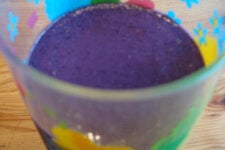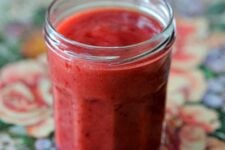Master the art of making smoothies with this guide to perfect smoothie ratios. Explore various ratios and combinations to blend fruits and greens into delicious, nutritious beverages tailored to your tastes.

(Yes, I have cocoa powder smeared all over my hand…)
What makes smoothies such a popular breakfast? Could it be the vibrant colors, the fab nutritious boost or just the fact that smoothies make any type of fruit better? Maybe it’s all of them. In today’s post, I want to show you that sometimes, the best recipes are well… NOT recipes.
Smoothies are the BEST for just experimenting and putting together all of your favorite things, and create your perfect drink. With these smoothie ratio’s, you’ll learn just how to make the perfect fruit or green smoothie and turn it into whatever you want it to be. As well as the ratio’s, I’ve included lots of pairing suggestions to get you started, as well as some great time saving tips, and my favorite equipment. So let’s jump right in!
Equipment

The key thing that you need to make a smoothie, is a blender. There are an abundance of blenders out there in all price ranges. I would love to own a Vitamix one day, but right now, my favorite blender is a Nutribullet. Price wise, these are pretty affordable in the market, and they are absolutely perfect for smoothies “on-the-go.” You can blend up your smoothie right in the cup you’re going to be taking with you, then pop on a lid with a handle and off you go!
Perfect Fruit Smoothie Ratios
Fruit smoothies are probably the kind of smoothie I make the most. I love testing out new combinations of fruit, or sticking with old favorites and decorating them in smoothie bowls. The key to a good fruit smoothie, no matter what fruit you’re using, is using ripe fruit.
I really can’t stress that enough. Under ripe fruit is not sweet, it’s often hard in texture, and it definitely doesn’t make a good smoothie. Ripe fruit should be sweet smelling, firm with a little give when gently squeezed and bright in color. Bananas are one of the most commonly used ingredients in smoothies, and they are ripe when they are yellow and have some brown speckles! Trust me, that’s when they are at their best!

There are two ratios that I always use for fruit smoothies, depending on whether the fruit is frozen or not. Personally, I prefer using the frozen fruit version, but the unfrozen is totally fine if you don’t have frozen fruit on hand!
Non-Frozen Fruit Smoothies
- 3 parts fruit
- 2 parts liquid
- 2-3 ice cubes
- 1-2 tbsp add ins
Frozen Fruit Smoothies
- 3 parts frozen fruit
- 3 parts liquid
- 1-2 tbsp add ins
Tip: Chop up the fruit for your smoothie the night before and freeze it in a container the night before. It will be ready to be blended super quickly so you can get going with your morning!

Perfect Green Smoothie Ratio
Green smoothies are an increasingly popular choice. Try this immune boosting Green Smoothie recipe, or make your own version using this ratio:
- 2 parts liquid
- 2 parts greens
- 3 parts frozen fruit
Tip: Blend the greens and the liquid first so that the leaves get super smooth before adding the fruit, then blend again. This will help the greens break down, so you don’t get any leafy chunks in your smoothie!

Flavor Combinations
Now this is the fun part. There really are no limits here, you can combine WHATEVER fruits you like. Below I have compiled a list of my favorite combinations, and suggestions of add ins that you can build on. This list is by no means a limit, add as MANY more items as you can think of!
Bananas – the base for MOST smoothies
Goes great with: Berries (all kinds), coconut, dates, figs, ginger, maple syrup, mangoes, orange, papaya, passion fruit, pomegranate, vanilla.
Tip: if you’re trying to maximize the health benefits of your daily smoothie, consider omitting the banana every other day. Recent research shows that bananas can actually reduce flavanols, those important antioxidative and anti-inflammatory compounds often found in other smoothie ingredients (1).
Berries
Examples: strawberries, raspberries, blueberries, blackberries, cherries, black mulberries, boysenberry, etc.
Goes great with: bananas, cooked beets, grapefruit, apricots, figs, lemon, ginger, maple syrup, mango, melon, mint, orange, nectarine, peach, pear, pineapple, plums, mint, vanilla.
Greens
Examples: Baby spinach, kale, swiss chard, beet greens, romaine lettuce, arugula, collard greens.
Goes great with: Personally, I like using acidic, citrus fruits and juice in green smoothies. Combinations such as pineapple, mango, orange, lemon, lime, ginger, grapefruit, pomelo all work really well. Also throw in some berries for a sweet hit.
Liquids
Water – the most basic way to create a light smoothie. Flavorless so let’s the ingredients shine through, creates a mild tasting smoothie.
Fruit juice – such as orange, pineapple, tropical, cranberry, pomegranate – goes best in banana/berry/green smoothies. Will create a fresh, bright smoothie. The flavor of juice complements greens beautifully.
Plant milks – such as oat, coconut, rice, almond (read a complete guide to non-dairy milk here). Goes great with berries and other sweet ingredients. Will create a rich, thick smoothie, great for post workouts or mornings when you need something a bit more filling.
Smoothie Add-Ins
The add ins might be my favorite part of smoothie making, they allow you to add some nutritional benefits to your smoothie, or just some great flavor. Here are some suggestions:
For berry based smoothies: Fresh ginger, lime juice, chia seeds, flax seeds, hemp hearts, cinnamon, avocado, lemon/lime zest, peppermint extract (just a couple of drops), vanilla, acai.
For banana based smoothies: cacao powder, macha powder, boabab, acai, chia seeds, flax seeds, hemp hearts, turmeric (just a pinch), avocado, peanut butter, almond butter, cashew butter, dates, cardamom (just a pinch), cinnamon, ginger, nutmeg (just a pinch) sesame seeds, coconut yoghurt.
For green smoothies: Fresh ginger, lime juice, chia seeds, flax seeds, hemp hearts, cinnamon, avocado, lemon/lime zest, vanilla, acai, turmeric (just a pinch), nut butters, dates, coconut yoghurt.
With all these skills above, you’ll be able to confidently get in the kitchen and make your own perfect smoothies, every time!
Try These Smoothie Recipes
Complete Guide to Perfect Smoothie Ratios
Equipment
- 1 blender
Ingredients
Non-Frozen Fruit Ratios
- 3 parts fruit
- 2 parts liquid
- 2-3 ice cubes
- 1-2 tbsp add-ins
Frozen Fruit Ratios
- 3 parts frozen fruit
- 3 parts liquid
- 1-2 tbsp add-ins








I’ve read a lot of smoothie guides because I make a ton of smoothie recipes for my blog but this guide is filled with tips that I will definitely link back to. I love the fact that you’ve actually tried the recipes and tips yourself before sharing them, this is something I plan on doing more of in the future. Thanks for sharing and have a wonderful day.
Thanks so much Lauren for being willing to share your recipes! I’ve tried a couple and they’re great.
Hey!
Thanks for an amazing guide. I’m however a bit confused about the ratios in your examples, since you mix both unspecified “parts” with fixed units (tbsp).
In this example:
3 parts frozen fruit
3 parts liquid
1-2 tbsp add ins
What is the measurement unit for 1 part that work with 1-2 tbsp add ins? Or if i rephrase, how many parts are the add ins?
Thank you!
Hampus